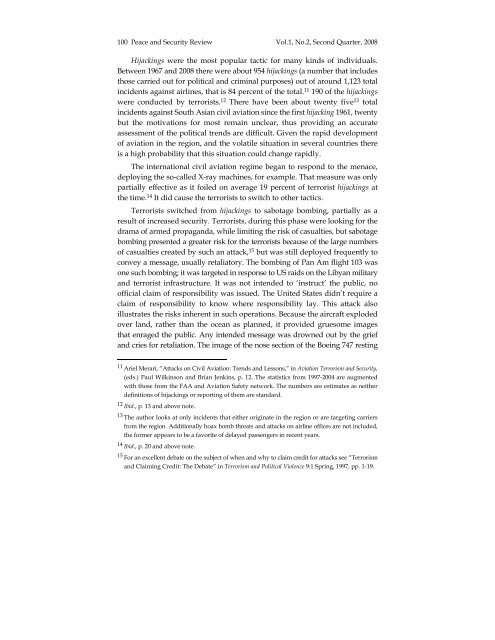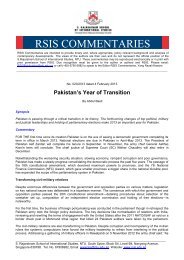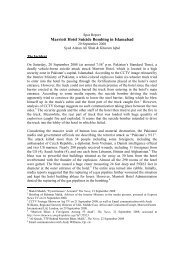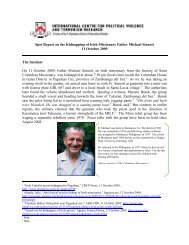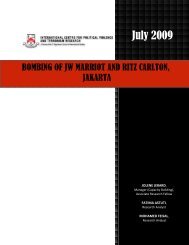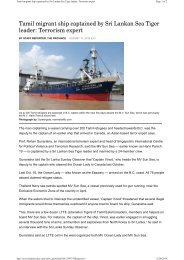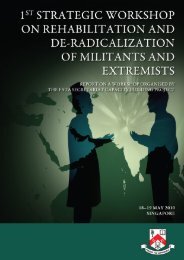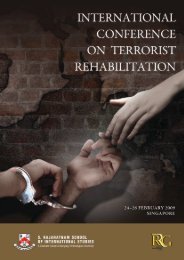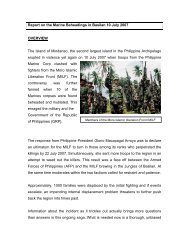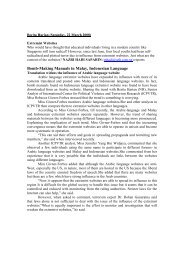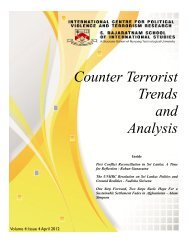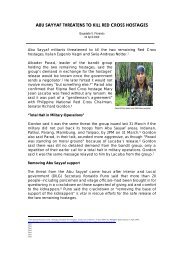Peace and Security Review, Vol.1 No. 2 - International Centre for ...
Peace and Security Review, Vol.1 No. 2 - International Centre for ...
Peace and Security Review, Vol.1 No. 2 - International Centre for ...
Create successful ePaper yourself
Turn your PDF publications into a flip-book with our unique Google optimized e-Paper software.
100 <strong>Peace</strong> <strong>and</strong> <strong>Security</strong> <strong>Review</strong> <strong>Vol.1</strong>, <strong>No</strong>.2, Second Quarter, 2008<br />
Hijackings were the most popular tactic <strong>for</strong> many kinds of individuals.<br />
Between 1967 <strong>and</strong> 2008 there were about 954 hijackings (a number that includes<br />
those carried out <strong>for</strong> political <strong>and</strong> criminal purposes) out of around 1,123 total<br />
incidents against airlines, that is 84 percent of the total. 11 190 of the hijackings<br />
were conducted by terrorists. 12 There have been about twenty five 13 total<br />
incidents against South Asian civil aviation since the first hijacking 1961, twenty<br />
but the motivations <strong>for</strong> most remain unclear, thus providing an accurate<br />
assessment of the political trends are difficult. Given the rapid development<br />
of aviation in the region, <strong>and</strong> the volatile situation in several countries there<br />
is a high probability that this situation could change rapidly.<br />
The international civil aviation regime began to respond to the menace,<br />
deploying the so-called X-ray machines, <strong>for</strong> example. That measure was only<br />
partially effective as it foiled on average 19 percent of terrorist hijackings at<br />
the time. 14 It did cause the terrorists to switch to other tactics.<br />
Terrorists switched from hijackings to sabotage bombing, partially as a<br />
result of increased security. Terrorists, during this phase were looking <strong>for</strong> the<br />
drama of armed propag<strong>and</strong>a, while limiting the risk of casualties, but sabotage<br />
bombing presented a greater risk <strong>for</strong> the terrorists because of the large numbers<br />
of casualties created by such an attack, 15 but was still deployed frequently to<br />
convey a message, usually retaliatory. The bombing of Pan Am flight 103 was<br />
one such bombing; it was targeted in response to US raids on the Libyan military<br />
<strong>and</strong> terrorist infrastructure. It was not intended to ‘instruct’ the public, no<br />
official claim of responsibility was issued. The United States didn’t require a<br />
claim of responsibility to know where responsibility lay. This attack also<br />
illustrates the risks inherent in such operations. Because the aircraft exploded<br />
over l<strong>and</strong>, rather than the ocean as planned, it provided gruesome images<br />
that enraged the public. Any intended message was drowned out by the grief<br />
<strong>and</strong> cries <strong>for</strong> retaliation. The image of the nose section of the Boeing 747 resting<br />
11 Ariel Merari, “Attacks on Civil Aviation: Trends <strong>and</strong> Lessons,” in Aviation Terrorism <strong>and</strong> <strong>Security</strong>,<br />
(eds.) Paul Wilkinson <strong>and</strong> Brian Jenkins, p. 12. The statistics from 1997-2004 are augmented<br />
with those from the FAA <strong>and</strong> Aviation Safety network. The numbers are estimates as neither<br />
definitions of hijackings or reporting of them are st<strong>and</strong>ard.<br />
12 Ibid., p. 13 <strong>and</strong> above note.<br />
13 The author looks at only incidents that either originate in the region or are targeting carriers<br />
from the region. Additionally hoax bomb threats <strong>and</strong> attacks on airline offices are not included,<br />
the <strong>for</strong>mer appears to be a favorite of delayed passengers in recent years.<br />
14 Ibid., p. 20 <strong>and</strong> above note.<br />
15 For an excellent debate on the subject of when <strong>and</strong> why to claim credit <strong>for</strong> attacks see “Terrorism<br />
<strong>and</strong> Claiming Credit: The Debate” in Terrorism <strong>and</strong> Political Violence 9:1 Spring, 1997, pp. 1-19.<br />
<strong>Vol.1</strong>, <strong>No</strong>.2 2008 pp.95-114


